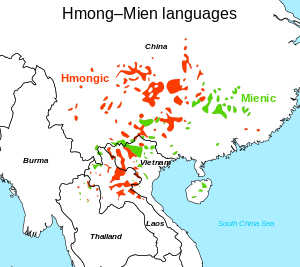Sino-Austronesian languages
Sino-Austronesian or Sino-Tibetan-Austronesian is a proposed language family suggested by Laurent Sagart in 1990.[1] Using reconstructions of the Old Chinese language, Sagart argued that the Austronesian languages are related to the Sinitic languages phonologically, lexically and morphologically. Sagart later acknowledged that the Sino-Tibetan languages are a valid group and extended his proposal to include the rest of Sino-Tibetan.[2] Additionally, the Tai–Kadai languages were placed internally within the Austronesian family as a sister branch of Malayo-Polynesian.[3] The proposal is controversial (see below), but still being debated.
Classification
- Sino-Austronesian (Sino-Tibetan–Austronesian)
Criticism
Ostapirat (2005)[4] supports the link between Austronesian and Kra–Dai (Sagart built upon Ostapirat's findings), but rejects a link to Sino-Tibetan. He notes that the apparent cognates are rarely found in all branches of Kra–Dai, and almost none are in core vocabulary.
Blust (2014)[5] notes that Sagart circumvents valid use of the comparative method, saying his "device for manufacturing evidence of genetic
relationship where none exists is what can be called 'fishing for dregs'", and that basic vocabulary is hardly represented in the comparisons.
Sagart (2016) [6] responds to some of the criticisms by Blust (2009).
Distributions
See also
References
- ↑ Sagart, L. (1990) Chinese and Austronesian are genetically related. Paper presented at the 23rd International Conference on Sino-Tibetan Languages and Linguistics, October 1990, Arlington, Texas.
- ↑ Sagart, L. (2005) Sino-Tibetan-Austronesian: an updated and improved argument. In L. Sagart, R. Blench and A. Sanchez-Mazas (eds) The peopling of East Asia: Putting together Archaeology, Linguistics and Genetics 161-176. London: RoutledgeCurzon.
- ↑ Sagart, L. (2004) The higher phylogeny of Austronesian and the position of Tai-Kadai. Oceanic Linguistics 43,2: 411-444.
- ↑ Ostapirat, Weera. 2005. "Kra–Dai and Austronesian: Notes on phonological correspondences and vocabulary distribution." Laurent Sagart, Roger Blench & Alicia Sanchez-Mazas, eds. The Peopling of East Asia: Putting Together Archaeology, Linguistics and Genetics. London: Routledge Curzon, pp. 107–131.
- ↑ Robert Blust (2014) "Some Recent Proposals Concerning the Classification of the Austronesian Languages", Oceanic Linguistics 53:2:300–391.
- ↑ https://benjamins.com/#catalog/journals/dia.33.2.04sag/details
- Blust, Robert 2009. The Austronesian languages. Canberra: Pacific Linguistics.
- Sagart, Laurent. 1990. Chinese and Austronesian are genetically related. Paper presented at the 23rd International Conference on Sino-Tibetan Languages and Linguistics, October 1990, Arlington, Texas.
- Sagart, Laurent. 1994. Proto-Austronesian and the Old Chinese evidence for Sino-Austronesian. Oceanic Linguistics 33:271–308.
- Sagart, Laurent. 2004. The higher phylogeny of Austronesian and the position of Tai–Kadai. Oceanic Linguistics 43:411–440.
- Sagart, Laurent 2005. "Sino-Tibetan–Austronesian: an updated and improved argument." In Laurent Sagart, Roger Blench & Alicia Sanchez-Mazas, eds. The Peopling of East Asia: Putting Together Archaeology, Linguistics and Genetics. London: Routledge Curzon, pp. 161–176.
- Sagart, Laurent 2016. The wider connections of Austronesian A response to Blust (2009). Diachronica, 33(2):255–281.
- Starosta, Stanley. 2005. "Proto-east Asian and the origin and dispersal of the languages of East and Southeast Asia and the Pacific." In Laurent Sagart, Roger Blench & Alicia Sanchez-Mazas, eds. The Peopling of East Asia: Putting Together Archaeology, Linguistics and Genetics. London: Routledge Curzon, pp. 182–197.
External links
|
|---|
|
|---|
|
|---|
| |
|---|
Central Malayo-Polynesian |
|---|
|
| |
|
|
|
| |
|
|
|
- Bold indicates languages with more than 1 million speakers
- ? indicates classification dispute
- † indicates extinct status
|







